Propagating string of pearls is very quick and easy. In this post I’ll show you exactly how to root the cuttings in either soil or water.
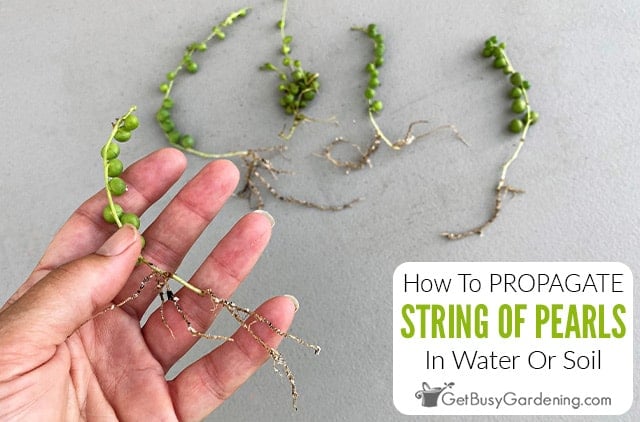
For anyone interested in learning how to propagate string of pearls, you’ll be excited to know that it’s simple and fun to do.
In this step by step guide I’ll discuss the different methods, and provide clear instructions on how to tackle the most common techniques.
The tips included here will help you multiply your Curio rowleyanus to create lots of new plants for yourself, friends, and family to enjoy.
String Of Pearls Propagation Methods
You can propagate string of pearls (Curio rowleyanus), aka string of beads, using several different techniques.
Division, cuttings, and seeds are all possible methods, but some are more common, and easier, than others.
And it doesn’t matter if you have the common variety, or a variegated one. They can both be multiplied using these techniques.
From Cuttings
It’s very easy to use stem cuttings from anywhere on the plant to multiply a string of beads.
Roots will form from the exposed leaf nodes along the stem in either water or soil.
Even individual leaves will work, but it’s more difficult, and will take much longer to get a full sized plant that way.
By Division
Division is a good way to quickly multiply a mature Curio rowleyanus, and is usually pretty easy. Simply pull out the rootball and separate it into several chunks.
Those can then be repotted into new containers to create several, larger new plants for you to enjoy.
From Seeds
When pollinated, the flowers can produce seed pods after they fade. You can leave them to dry, and then collect them.
This method, while possible, is the most difficult and unreliable. Only a few typically germinate, and it takes a very long time to produce a mature plant.
When To Propagate String Of Pearls
The best time to propagate string of pearls is during the warmer months, during their active growth period. That will allow it to root and produce new starts much faster.
Aim for the spring or summer, or you could do it in the fall if you live in a warm climate.
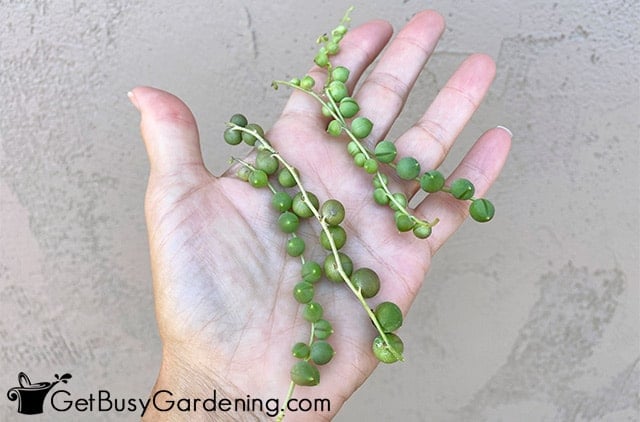
Propagating String Of Pearls From Stem Cuttings
The first step in successfully propagating string of pearls is learning how to take and prepare the stem cuttings. It’s not hard, but doing it right is an important first step.
How To Take Stem Cuttings From Curio rowleyanus
Start by selecting a few 3-5” sections of healthy, well-hydrated vines with several leaves attached. Choose ones without flowers, or pinch off any that have formed.
You can also take one long cutting and trim it into smaller sections if you’d like.
Use a sharp, sterile pair of micro snips to cut the stem just above a set of leaves.
Preparing String Of Pearls Stem Cuttings For Propagation
Once you’ve gathered your cuttings, strip off all of the leaves on the lower 2-3”. You want to expose at least 3-4 leaf nodes to allow for good root development.
Then let them sit out to callous for a day or two. This is to help prevent rot during rooting.
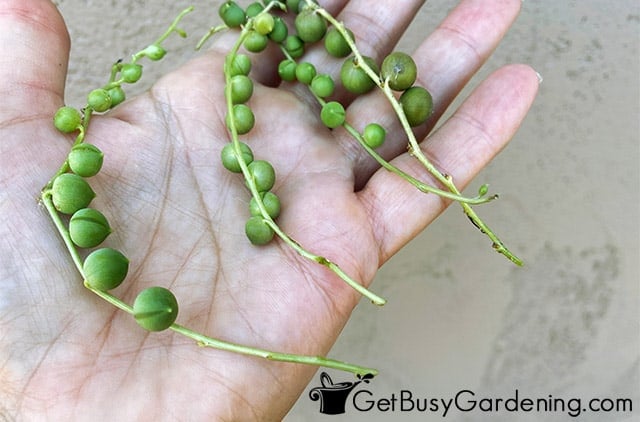
Propagating String Of Pearls From Leaves
It is possible to propagate string of pearls from a single leaf. But it can take a very long time to generate a full-sized plant, and it only works in soil.
Even then, this method is not always successful. But it can be a fun experiment to try with the leaves you removed from your stem cuttings.
How To Take String Of Pearls Leaf Cuttings
Snip fully hydrated, healthy leaves where they connect to the main vine with sterile, sharp pruners.
Be sure that the little stem that connects it is still attached to the leaf, or it won’t be able to root.
Preparing Curio rowleyanus Leaves For Propagation
The leaves require very little preparation. Rot is the main issue when multiplying from a single leaf.
So let them sit for a day or two to callous over, but not to the point where they start to shrivel.
How To Root String Of Pearls Cuttings (Stems & Leaves)
With your prepared stem cuttings or leaves in hand, you’re ready to start. Below you’ll find a detailed supply list and step by step instructions. The exact tools you’ll need will vary based on the technique you use. Here’s a comprehensive list.
Supplies Needed:
- String of pearls cuttings
- Micro-snip pruners
- Rooting hormone
- Rooting medium or water
- A pot or vase
- Pencil or chopstick
- Heat mat (optional)
- Trowel
Steps For Rooting String Of Pearls In Soil
Propagating string of pearls in soil is a reliable method that produces hardy roots in just a few weeks. They’re also less likely to rot or experience transplant shock when you pot them up.
Step 1: Prepare the rooting medium – A medium that is fast-draining and loose is ideal for propagating string of pearls.
Try mixing equal parts of regular potting soil with perlite or pumice, and coarse sand to create your own.
Step 2: Prepare the container – Lightly moisten the rooting medium, but avoid making it soggy. Use a trowel to fill the pot with several inches of the dampened mixture.
Step 3: Make holes – Use a pencil, chopstick, or your finger to make holes 2-3” deep. You can put several cuttings into the same pot. If you’re using single leaves, you won’t need holes.
Step 4: Apply rooting hormone – Dust the exposed leaf nodes or the stem of the individual pearl with rooting hormone. It’s an easy way to encourage faster, stronger roots.
Step 5: Plant them – Place the dusted end of the cuttings into the prepared holes. Gently pack the medium around the stems to keep them in place.
For single leaves, gently press the attached nub of stem into the medium, ensuring the entire top is above soil. If they’re buried too deep, they can rot.
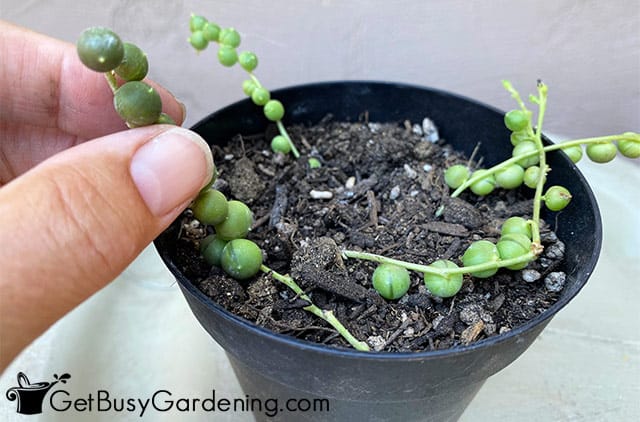
Step 6: Place somewhere warm and bright – Put them in a location with plenty of bright, indirect light. A heat mat can speed things up, especially if the air is cold, but it’s optional.
Step 7: Keep slightly damp – Don’t water to the point of making the medium soggy, just enough to keep it from drying out completely. If it’s too wet, the cuttings and leaves will only rot.
Steps For Rooting String Of Pearls In Water
Propagating string of pearls in water can be fast and easy. But there’s more risk for rot. Plus the roots are usually weaker, and can have a hard time transitioning back to soil. So pot them up as soon as the roots are 1-2” long.
Step 1: Fill the vessel with water – Use a small jar, vase, or bowl, and fill it with just enough lukewarm water to cover only the stems. I prefer a clear container so I can see the roots develop, but any will work.
Step 2: Submerge the nodes – Place the cuttings in the water deep enough to submerge at least 1-2 exposed leaf nodes, though more is ideal.
You can put several cuttings into one vase, but make sure none of the leaves touch the water or they can rot.
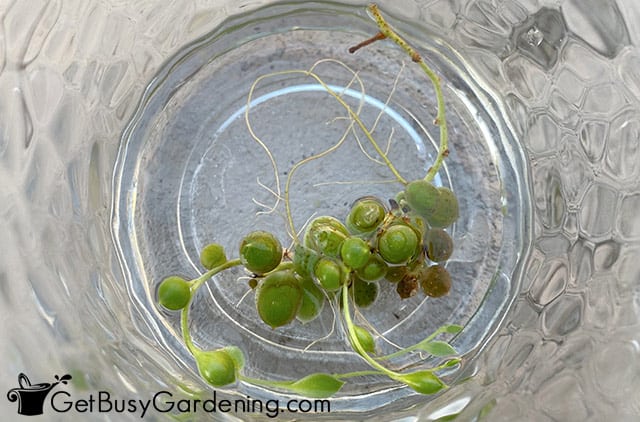
Step 3: Place in a bright location – Put the container in a bright location that receives plenty of indirect light until the roots form.
Step 4: Keep the water clean – If you begin to see murky or cloudy water, rinse the container and refresh it with lukewarm water.
Step 5: Wait for roots to form – When they cuttings have formed roots that are at least 1” long, pot them up. Don’t wait any longer, or they can become weak or start rotting.
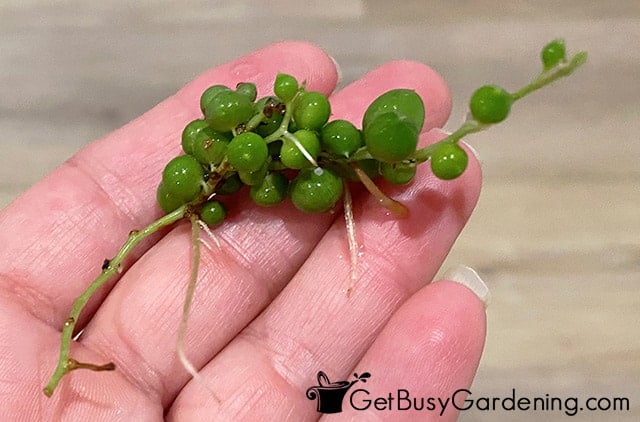
How Long Does It Take For String Of Pearls Cuttings To Root?
How long it takes for string of pearls cuttings to root depends on the environment.
They can root very quickly, in as little as a few days, but sometimes it can take up to a month.
Why Won’t My Curio rowleyanus Propagate?
There are many reasons why a string of pearls won’t propagate. Too much or too little moisture, lack of light, or cold temperatures can all be factors.
Keep the soil lightly moist, or make sure the nodes are always submerged in water. If you have trouble providing enough light, adding a grow light can be helpful.
Warmth is also helpful. A heat mat can be a useful tool if you’re trying it during a colder time of year, or your house is chilly.
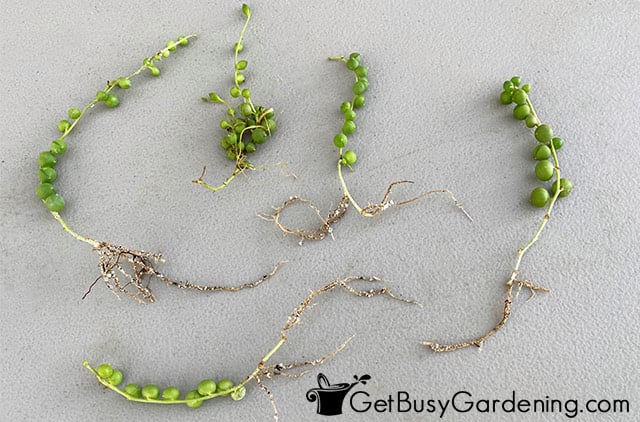
How To Care For String Of Pearls Babies
When roots are sturdy enough, pot them up in containers with good drainage, in a coarse, free-draining soil mixture.
Keep them lightly moistened and in indirect light while they settle into their new homes. It’s not uncommon to see some signs of transplant shock, especially for those rooted in water.
Shriveling, dropping, or discolored leaves are all signs of that. Give them a few weeks to recover, then resume regular care.
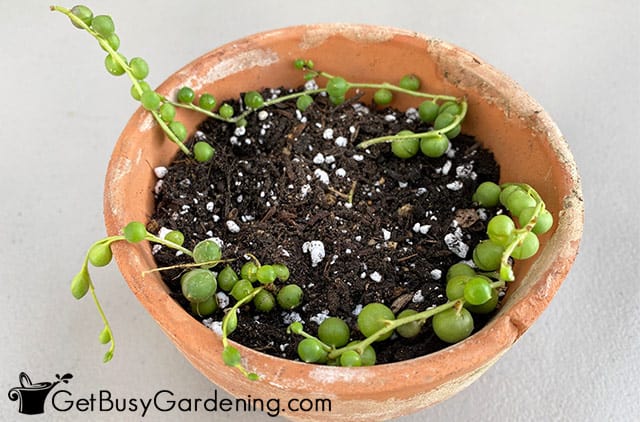
FAQs
Here I’ve answered some of the most commonly asked questions about string of pearls propagation. If yours isn’t listed, please add it to the comments section below.
What is the fastest way to propagate string of pearls?
The fastest way to propagate string of pearls is in water. But they’re more prone to rotting, and it can result in weaker roots that are harder to transition to soil. Also, this method also only works with cuttings, not individual leaves.
Can you propagate string of pearls from one pearl?
Yes, you can propagate string of pearls from one pearl, or leaf. It needs to have the stem that connected it to the main vine still attached. They can only be rooted in soil, as they will only rot in water.
Can string of pearls grow from a cutting?
Yes, string of pearls can grow from a cutting. In fact, it’s the easiest and most reliable way to multiply an existing plant.
Can string of pearls root in water?
Yes, string of pearls can root in water, and it’s very quick and easy. But they can be more delicate, so they need to be transitioned to soil as soon as they develop roots 1” long.
Now that you know the steps and tools needed to propagate string of pearls, you can easily multiply yours. It’s a great way to expand a single plant into many to enjoy and share.
If you want to learn how to multiply all of your plants, then my Plant Propagation eBook is for you! It will show you how to create new plants from any of the ones that you already have, step by step. Download your copy today!
More About Plant Propagation
- Plant Propagation: A Detailed Guide For Beginners
- Propagating Succulents In Winter
- How To Propagate Aloe Vera By Division
- Propagating Succulents From Stem Cuttings Or Leaves
- Propagating Peperomia In Water Or Soil
Share your tips for how to propagate string of pearls in the comments section below.
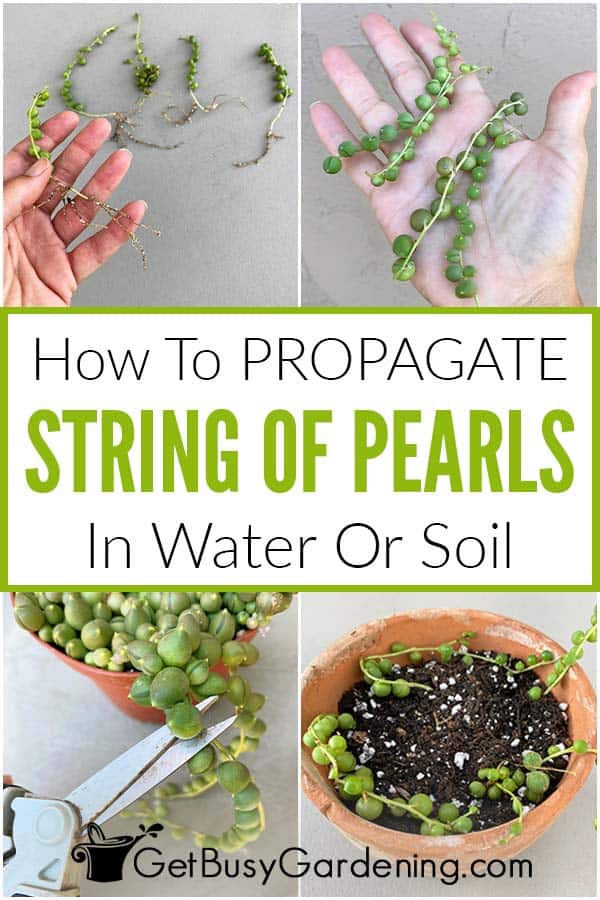
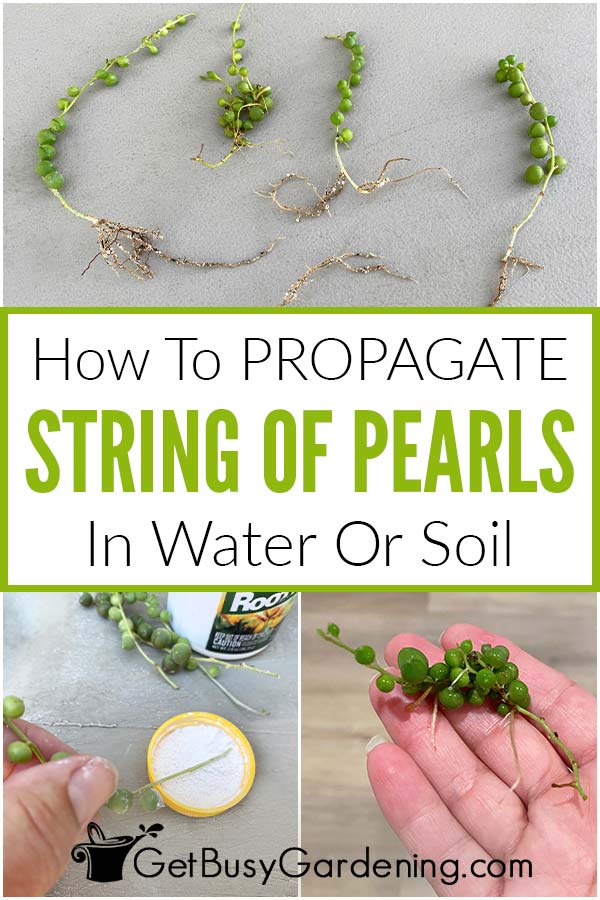
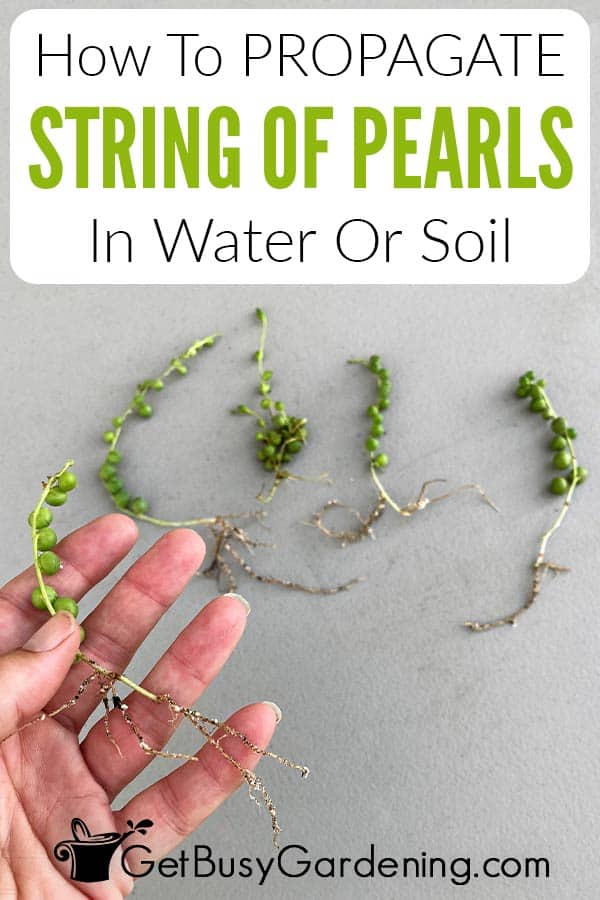

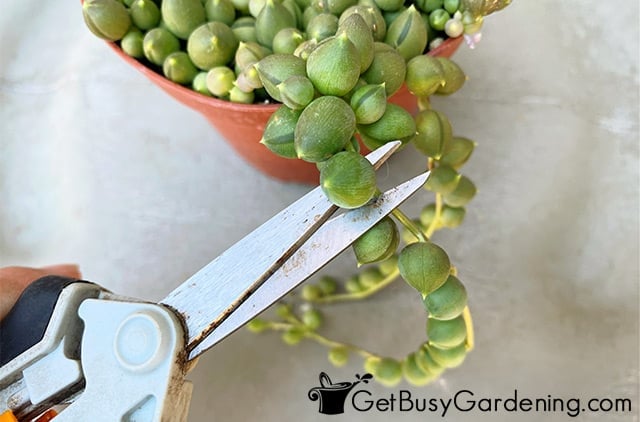
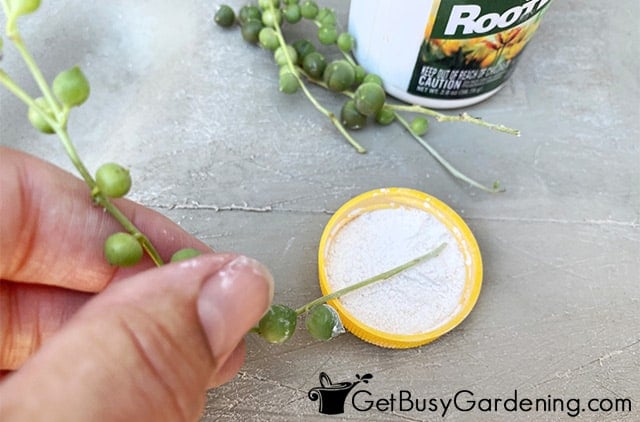


Leave a Reply